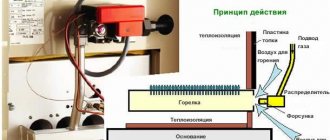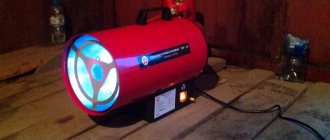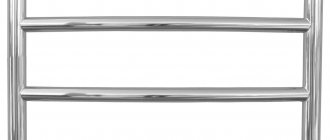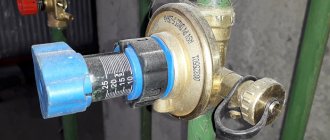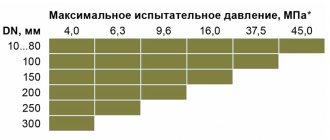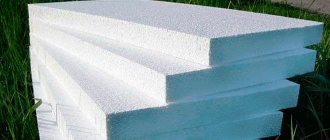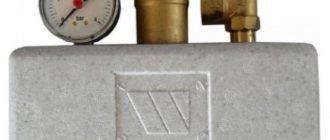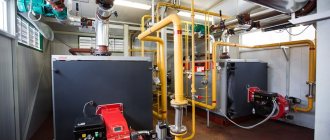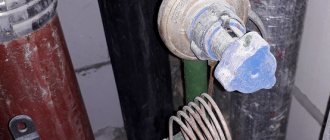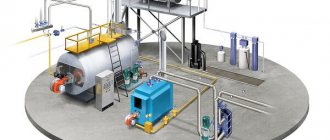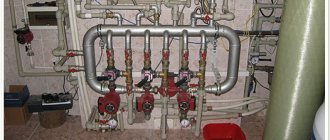Today, when typing on the Internet such keywords as “installation for spraying polyurethane foam,” “foam generator foam generator,” or “equipment for processing polyurethane foam,” we will find a huge selection of, at first glance, various models and brands of equipment. Indeed, over the past 5-6 years, both the presence of sellers and the number of equipment manufacturers have increased significantly. But, unfortunately, we cannot say that quantity translates into quality. This abundance and catchy, contradictory advertising phrases from sellers often make it difficult to choose the optimal equipment for specific purposes and tasks. Let's try to figure it out. In summary, there are three types of devices for applying polyurethane foam:
- low pressure installations
- high pressure installations
- portable and cartridge kits for self-application
In this article we will analyze and compare the first two types of installations, since they are the ones used to conduct business in the field of polyurethane foam processing. While portable and cartridge kits, on the contrary, are more often an option for “home” use by ordinary people and, as a rule, for carrying out small volumes of work.
Operating principle of the installations
Devices for spraying low-pressure polyurethane foam (also called foam generators) are installations in which the components are mixed in the chamber of a spray gun at a pressure of 5-10 atmospheres. The mixing process itself occurs under the action of compressed air from the compressor; Air jets create turbulence of chemical components in the mixing chamber of the spray gun. Pressure, in most cases, is created by gear pumps.
Devices for spraying high-pressure polyurethane foam are installations in which raw materials are mixed in the chamber of a spray gun at a pressure of over 100 atmospheres. The components are mixed due to mutual diffusion of flows under pressure. Compressed air is used only to clean the nozzle of the spray gun. Pressure, in most cases, is created by plunger pumps.
The key difference between these types of installations is the principle of mixing the initial components. However, this does not mean at all that one method is better than another, these are only technological features of the equipment.
FOAM GENERATOR NAST-3
Purpose: applying heat-insulating polyurethane foam coating to walls, roofing, pipelines. For heat and cold insulation of equipment, tanks, and in the preparation of thermal vans. For sealing interpanel seams on buildings and roof repairs.
Contents: - foam generator - spray gun PR-6 - connecting hoses (5-10 m) - passport
Specifications:
| Foam generator type | low pressure |
| Foam capacity, kg/min | from 0.2 to 3.0 |
| Basic ratio of components A:B (can be changed as desired) | 1:1,1 |
| Pressure in the component supply system, MPa, no more | 0,5 |
| Pressure in the air supply system, MPa | 0,4-0,6 |
| Nominal compressed air consumption, m3/hour | 30 |
| Thermostat system | No |
| Supply voltage, V/power consumption, kW/hour | 220/0,45 |
| Hose length, m | 5-10 |
| Overall dimensions, mm | 520x240x505 |
| Weight, kg | 34 |
| Capacity volume | 24l x 2 |
| Warranty, months | 12 |
Features: The extremely simple design of the foam generator allows for high-quality thermal insulation work with polyurethane foam. It is equipped with a new type of spray gun that does not require cleaning with special compounds. The device is equipped with the latest PR-6 spray gun, which differs from previous models in its simpler and shorter nozzle design. Thanks to this, the gun does not require special cleaning. The gun is distinguished by a new internal structure, which allows for a better mixing of liquid components.
Pros:
- + Low cost of equipment, which means minimal investment at the start of a business. The most budget options for devices start from 65,000 rubles.
- + Small dimensions and weight of installations. Typically the weight does not exceed 100 kg, which makes it possible to move the equipment with one or two people. The dimensions of most installations allow them to be transported even in a passenger car (not counting raw materials).
- + Ease of operation - no complex mechanisms or electronics.
- + Relatively inexpensive components and ease of maintenance. Equipment repairs are often carried out using improvised means.
- + The two points above indicate that there is no need for highly qualified operator. This is good for those new to this business.
- + It is possible to change the ratio of components from 1:1 to 1:2 with different steps. This allows you to work with almost any type of component to obtain polyurethane foam.
- + The performance of the device varies smoothly over a wide range without stopping work. This makes it easy to adjust performance to on-site operating conditions.
- + The required voltage is 220 V, while the power of the device itself usually does not exceed 3 kW (excluding the compressor), which allows you to connect even at home.
Minuses:
- — It does not allow the processing of polyurea, which is quite in demand today.
- — “Simple” models are low-productive and have unreliable working units (even the use of a drive from a conventional drill).
- — Most installations involve the use of hoses to supply components to the spray gun, no more than 30 m in length.
- — The air supplied into the chamber of the spray gun creates a cloud of suspended foam components near the spraying site. There are difficulties with stabilizing the spray “torch”.
- — Less uniform layer and density of the resulting polyurethane foam, as a result, less uniform thermal conductivity.
- — Slightly higher consumption of raw materials compared to high-pressure units.
Pros:
- + High productivity of installations. Allows you to quickly cover large surface areas - up to 500 sq.m in 8 hours (depending on processing conditions and equipment model).
- + It is possible to use hoses for supplying components to the spray gun with a length of up to 125 m.
- + Polyurea can be processed (only in installations with pressures above 200 atmospheres).
- + More uniform layer and density of the resulting polyurethane foam, as a result more uniform thermal conductivity.
- + Due to airless spraying of polyurethane foam, the “cloud” of suspension near the spraying site is reduced.
- + More economical consumption of raw materials compared to low pressure equipment.
- + Electronics and technologically advanced working units make it possible to achieve high dosing accuracy, this has a positive effect on the quality of the resulting PU foam.
FOAM GENERATOR TMS-5
Purpose: the installation is intended for performing spraying work on thermal insulation of horizontal and vertical surfaces.
Contents: - foam generator - spray gun PR-6 - filling block - connecting hoses (5-10 m) - passport
Specifications:
| Foam generator type | low pressure |
| Foam capacity, kg/min | from 0.2 to 5.0 |
| Basic ratio of components A:B (can be changed as desired) | 1:1,1 |
| Pressure in the component supply system, MPa, no more | 0,5 |
| Pressure in the air supply system, MPa | 0,4-0,6 |
| Nominal compressed air consumption, m3/hour | 30 |
| Thermostat system | No |
| Supply voltage, V/power consumption, kW/hour | 220/2,5 |
| Hose length, m | 5-10 |
| Overall dimensions, mm | — |
| Weight, kg | — |
| Capacity volume | — |
| Warranty, months | 12 |
Features: The unit is equipped with a wheelbase. Components are collected from any consumable containers. The device can be equipped with a filling unit, which allows the production of molded products from polyurethane foam, as well as the filling of inter-wall spaces. There is built-in protection against power surges in the network. Equipped with a digital display. The device is equipped with the latest PR-6 spray gun, which differs from previous models in its simpler and shorter nozzle design. Thanks to this, the gun does not require special cleaning. The gun is distinguished by a new internal structure, which allows for a better mixing of liquid components.
Minuses:
- - High cost of equipment - from 500,000 rubles, and for simplified models of installations. Installations that allow spraying polyurea usually cost from 1 million rubles.
- — To work on expensive equipment, qualified personnel with appropriate remuneration are required.
- — For most installations, it is impossible to change the basic 1:1 ratio of polyurethane foam components. In some cases, this simply does not allow the processing of certain types of raw materials.
- — The complexity of the design and the high cost of repairs, which is proportional to the cost of installation. This is a particularly pressing problem due to frequent fluctuations in exchange rates.
- — Installations weigh on average from 150 to 350 kg, and for their transportation, as a rule, a minibus or truck is used.
- — Productivity mainly changes by replacing one mixing chamber with another, which requires disassembling the spray gun, which is perhaps not very technologically advanced. The range of performance changes during such manipulations is not high.
- — The required voltage is 380 V (not counting some simplified models), while the power of the device itself usually exceeds 13 kW (excluding the compressor), which in some cases requires the use of a diesel power generator.
Separately, I would like to touch on several important points. There are opinions floating around on the Internet and among beginners that high-pressure machines do not require compressor equipment and the spray gun can be cleaned without solvent. Alas, this is not true. To blow through the gun nozzle, a compressor is required, but for pneumatic installations without a compressor, in general, there is no way. As for cleaning and solvent, ask any experienced operator and make sure that this cannot be avoided. Just keep in mind that you may have to clean guns on low-pressure equipment more often, but on high-pressure equipment they are much more complicated and more labor-intensive to clean.
The issue of the quality of the resulting polyurethane foam is also often discussed. Quality must be confirmed by testing polyurethane foam samples obtained in various installations. And if the characteristics of polyurethane foam correspond to the figures declared by the raw material manufacturer, then the issue of quality becomes a matter of preference.
conclusions
I hope that this article has shown that the choice of equipment for applying polyurethane foam is not as obvious as it might seem at first glance. It is possible that low-pressure units are somewhat inferior in technology and efficiency, but they can be a good choice for starting a polyurethane foam spraying business due to their low cost and ease of operation. Large players in the polyurethane foam spraying market, as a rule, have installations of both types. Orders with a small volume of work, with the need to move the installation or with the ability to connect only 220 V are carried out on low pressure installations. While large-scale work or work combined with polyurea spraying is performed on high-pressure installations.
In addition, the specific model of equipment is also important. For example, there are low-pressure installations on the market that are quite good in quality, but at the same time, it is a shame for some installation manufacturers. Therefore, even before purchasing, it will be useful to consult with the owners of the installations, whose contacts manufacturers are usually willing to share, as well as talk about this topic with suppliers of raw materials.
For more information on this topic, see:
- Spraying polyurethane foam – what is it?
- Polyurethane foam
- Polyurea
Types of filling polyurethane foam
The polyurethane foam filling installation is a mechanized complex, inside which two liquid components are mixed qualitatively. It is a polyol and isocyanate. According to the documentation adopted in the Russian Federation, polyol is labeled as component A, isocyanate as component B. A dosed volume of these liquids is supplied to the mixing chamber.
IMPORTANT! The components are thoroughly mixed in the chamber. This function is performed by a dynamic mixer without the use of compressed air. The composition obtained as a result of mixing is fed into a form prepared specifically for this operation. A similar process is called polyurethane foam filling.
There are a number of excellent domestic manufacturers of installations for filling. The most popular products on the Russian polyurethane foam market are aggregates, Moscow. The company is an industry leader and offers its partners various types of machines for pouring polyurethane foam:
PK-60 – 60 liters per minute;
PK-90 – 90 liters per minute;
PK-200 – 200 liters per minute.
Each unit differs slightly from the others in its design, mainly in performance. The basis of all complexes:
- filling unit;
- hydropneumatic capacity;
- pump dosing device.
The remaining components and mechanisms are additional options used to automate, simplify, and control the quality of the pouring process. Depending on the type of foam used and performance, each filling foam is equipped with them. You can buy such equipment on the Internet portal and through the sales department of the enterprise.
Differences in machine performance
Each filling machine has its own production volumes and individual power characteristics. It is not difficult to buy equipment for pouring polyurethane foam, however, before purchasing it is necessary to clearly analyze your own needs for this equipment. The unified classification of polyurethane foam filling equipment provides for the production of two groups of machines:
- Small, with a filling capacity of up to 12 liters per minute.
- Large, with a filling capacity of up to 48 liters per minute.
NOTE!
Small units are equipped with 3G electric motors with a power of 0.75 kW and a voltage of 220 V. The rotor rotates under load inside the mixing chamber with a frequency of 3000 - 4200 rpm. The volume of the mixing chamber is 200 cm³. Manufacturer's warranty: one year from the date of commissioning into permanent operating mode, but no later than 90 days from the date of sale.
Large units are equipped with 3G electric motors with a power of 0.75 kW and 1.1 kW, a voltage of 380 V. The rotor rotates under load inside the mixing chamber with a frequency of 3900 - 4500 rpm. The volume of the mixing chamber is 280 and 340 cm³. Manufacturer's warranty: one year from the date of commissioning into permanent operating mode, but no later than 90 days from the date of sale.
Difference in linear and autonomous operation
When operating low-pressure units, the components are mixed in a mixing chamber with a working pressure of 6-10 atm. When pouring, the entire mass is mixed with a mixer. The latest models produced by Polymer-Complex PC are equipped with polyol and isocyanate heating units.
The high-pressure polyurethane foam system mixes components in a mixing chamber at an operating pressure of 140 atm. With this technology, the components are mixed, penetrating each other. The price for a high-pressure installation on the polyurethane foam market reaches 300,000 rubles. The polyurethane foam filling system in Moscow involves the parallel operation of both low and high pressure units.
ADDITIONAL INFORMATION
Autonomous operation of the PU foam filling machine consists in the complete independent functionality of the unit. Mixing of liquid substances is carried out in a closed chamber. Next, the mixture flows through a rod with slot-shaped nozzles into the poured mold. Polymerization of the resulting emulsion is achieved instantly through a spray torch on the surface of the base.
The installation is equipped with special guns to accurately hit the foam jet into the mold. The productivity is 6-20 liters per minute. This is how an autonomous pouring machine works. The installation price is 50-100 thousand rubles. Linear pouring machines are not much different from their stand-alone counterparts. They successfully work on main pipeline routes and bridge construction.
Their filling molds are much larger. Linear units have a capacity from 10 to 500 liters per minute. The cost of such units is 300,000 - 500,000 rubles or more.
